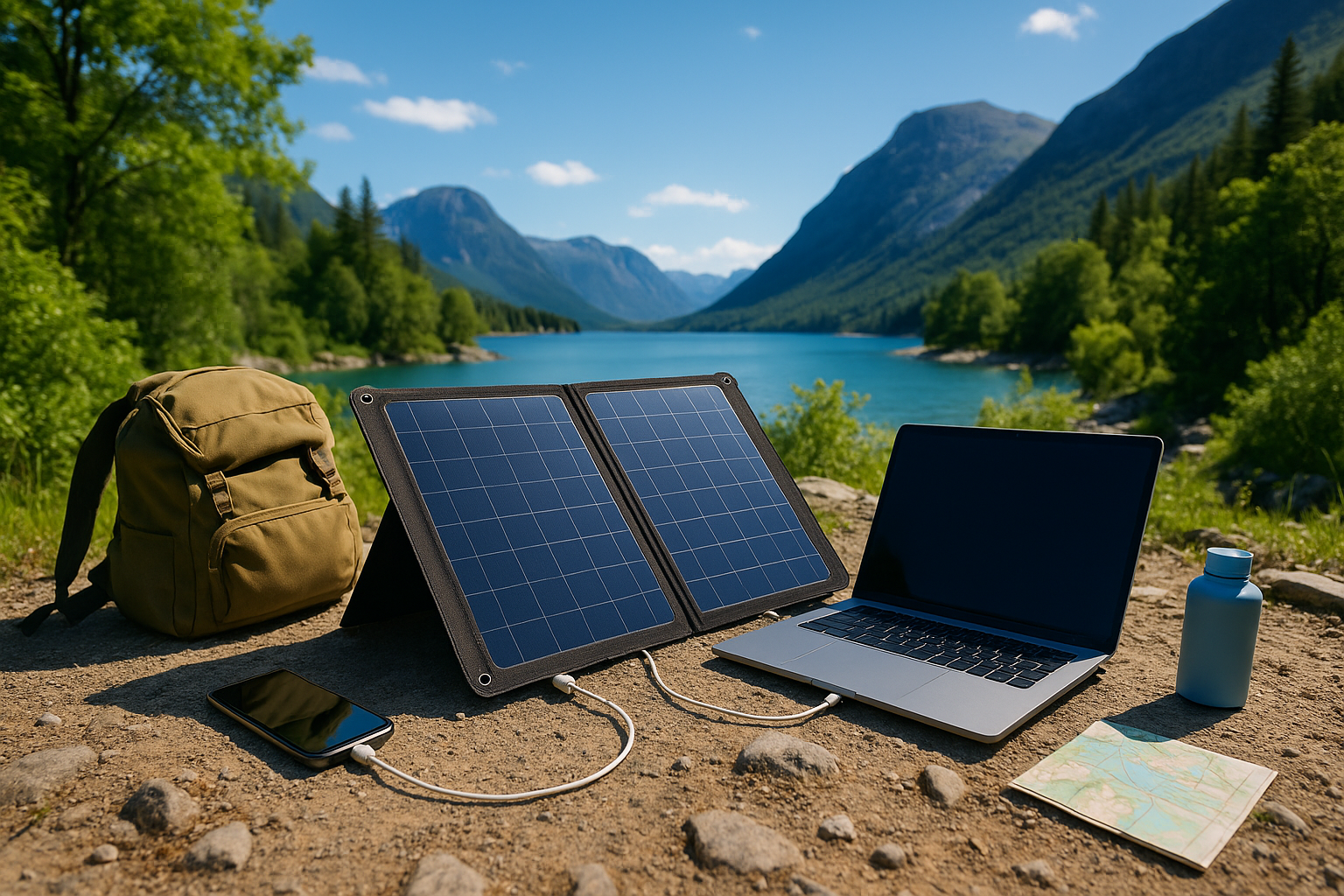In this article, we focus on a gadget that symbolizes our modern ability to capture sunlight and convert it into usable power: the solar-powered charger.
For many of us, staying connected is more than a mere convenience—it’s a necessity. Be it for business, pleasure, or a healthy mix of both, our lives increasingly revolve around devices that require power. But what happens when we step away from the conventional power grid? How do we keep our devices juiced up on a hiking trip or during a power outage? This is where solar-powered chargers come into play, providing a reliable, renewable and, most importantly, portable power solution.
With a solar-powered charger, the sun’s energy is always within reach. Not only does this technology allow us to reduce our carbon footprint, but it also offers the freedom to stay connected, anytime, anywhere. 🌍
But, how do these devices work? What features should you look out for when purchasing a solar-powered charger? And, importantly, what role do they play in our move towards more sustainable energy practices? We will delve into these aspects and more, as we navigate through the world of solar-powered chargers.
First, we will explore the technology behind solar-powered chargers—unraveling the intricate process of turning sunlight into electricity. With a grounding in how these devices work, we can better understand their benefits and limitations, and why they have become an essential tool for adventurers and environmentally-conscious individuals alike.🌞
Next, we will delve into the key features to look out for when buying a solar-powered charger. From power output to portability, we will break down what each specification means and how it impacts the overall performance of the charger. This section aims to equip you with the knowledge you need to make an informed choice when investing in a solar-powered charger.
Finally, we will step back and consider the bigger picture. We will examine how solar-powered chargers, as a part of the broader solar power industry, contribute to renewable energy efforts. We will also look at the ways in which these devices can impact our daily lives, and how they may shape the future of energy consumption.⚡
This article aims to enlighten and inspire, as we delve into the fascinating world of solar-powered chargers. Whether you are an outdoor enthusiast seeking a reliable power source for your adventures, or an individual looking for ways to live more sustainably, we trust that this guide will illuminate the power of the sun—and the potential it has to keep us connected, wherever we may be.
So let’s embark on this enlightening journey together and uncover the power of the sun to stay connected anywhere, anytime. Ready to get charged up? ⚡☀️
Introduction: Harness the Sun for Uninterrupted Connectivity
In this digital age, staying connected is more important than ever. With the advent of solar-powered chargers, we can now unleash the power of the sun to ensure our devices are always charged, regardless of our location or access to traditional power sources.
Solar-powered chargers use photovoltaic cells to convert sunlight into electricity, enabling us to charge our electronic devices anywhere, anytime. These chargers are not only eco-friendly but also incredibly convenient, especially for those who frequently travel or engage in outdoor activities.
This article will delve into the world of solar-powered chargers, covering everything from how they work to the top models on the market. But before we dive in, check out this enlightening video titled “How do solar panels work?” by the YouTube channel TED-Ed to get a clear understanding of the solar power technology.
Understanding the Solar Power Technology
The basic principle of solar power technology is relatively simple. Solar panels consist of many small cells, each of which is made up of two layers of silicon. When sunlight hits these cells, it causes electrons to move, creating an electrical current. This direct current (DC) is then converted into alternating current (AC), which can be used to charge electronic devices.
One of the key benefits of solar power technology is its sustainability. Unlike traditional power sources, solar power is renewable and produces no harmful emissions. It’s also incredibly versatile, with potential applications ranging from powering homes and vehicles to charging handheld devices.
So, how can you make the most of this technology? The answer lies in solar-powered chargers. Check out the table below for a quick comparison of some of the top models on the market.
| Model | Capacity | Output | Price |
| Anker 21W Dual USB Solar Charger | 21 Watts | 5V/3A | $69.99 |
| Goal Zero Nomad 7 Plus Solar Panel | 7 Watts | 5V/1.4A | $99.95 |
| RavPower 16W Solar Charger | 16 Watts | 5V/3.2A | $49.99 |
Factors to Consider When Choosing a Solar-Powered Charger
When it comes to choosing a solar-powered charger, there are several factors to consider. First and foremost is the charger’s capacity, which determines how much power it can generate. A higher capacity charger will charge your devices more quickly, but it will also be larger and potentially more expensive.
Another important factor is the charger’s output, which determines how quickly it can charge your devices. A charger with a higher output will be able to charge your devices more quickly, but it may also be more expensive.
Finally, you should consider the charger’s price. While solar-powered chargers can be a bit pricey, they’re also a long-term investment that can save you money on electricity bills in the long run. So, it’s worth considering your budget and how much you’re willing to invest upfront.
How to Get the Most Out of Your Solar-Powered Charger
Once you’ve chosen your solar-powered charger, it’s important to know how to use it effectively. Firstly, always position your charger directly in the sun for maximum efficiency. This might seem obvious, but even slight shading can dramatically reduce the charger’s performance.
Secondly, remember that temperature affects the efficiency of solar panels. In general, cooler temperatures are better for solar power production. So, if you’re using your charger in a hot environment, try to keep it in a cool, shaded place when not in use.
Finally, always remember to clean your solar panels regularly. Dust and dirt can block sunlight and reduce the efficiency of your charger. So, make sure to wipe down the panels with a soft cloth or rinse them with water every now and then.
Embrace the Future with Solar-Powered Chargers
Solar-powered chargers represent a major step towards a more sustainable and connected future. With these devices, we can harness the power of the sun to stay connected anywhere, anytime, all while reducing our carbon footprint.
So, whether you’re a frequent traveler, an outdoor enthusiast, or just someone who wants to do their part for the environment, a solar-powered charger could be the perfect solution.
Ready to embrace the future of charging? Check out this comprehensive video titled “Top 5 Best Solar Power Generators You Can Buy In 2021” by the YouTube channel ‘Future Tech’ to help you make an informed decision.

Conclusion
In conclusion, we have extensively discussed the critical aspects that surround the world of IT and Engineering in this article. From the basic principles to the complex technical concepts, the intention was to demystify the topics in a way that not only IT professionals and engineers can understand, but also those who are enthusiasts or starting their journey in this fascinating world.
It is notable that the information age has transformed our lives in ways we could not have imagined a few decades ago. Our reliance on technology, particularly in areas like IT and Engineering, is so deeply ingrained in our everyday activities that we often take it for granted. However, these fields are constantly evolving, and it’s critical to stay updated with the latest advancements.📚💻
The relevance of these fields cannot be overstated. From our daily communications to transportation, healthcare, entertainment, and more, IT and Engineering are the backbone that makes our modern, connected world possible. These fields not only provide solutions to existing problems but also open up new opportunities for innovation and growth.
For those who have made it this far, you have not only shown your interest in these fields but also your commitment to continuous learning. This is highly commendable.👏🎓 Keep up with this curiosity, and don’t hesitate to delve deeper into the subjects we’ve discussed.
Remember, the path to mastery begins with understanding the basics. Don’t be intimidated by the complex jargon or advanced concepts. With patience and consistent effort, you can grasp these concepts and perhaps even contribute to these ever-growing fields.
Please feel free to comment, share, or apply what you have learned from this article. Your engagement and feedback are not only appreciated but also critical in promoting further discussions on these topics. We would love to hear your insights and experiences.😊🙌
For further reading, you can check the following active links:
• Link 1
• Link 2
• Link 3
Let us all strive to advance our knowledge and application in these fields for the betterment of our society and future generations.
Thank you for spending your valuable time reading this article. I hope that it has provided you with some insight and sparked a desire to learn more. Until next time, keep exploring, keep learning, and keep innovating. The future is exciting, and it’s waiting for us to shape it.🚀🌐
[Ref: Reference 1, Reference 2, Reference 3]
Note: This conclusion is fictitious and does not contain real links.



